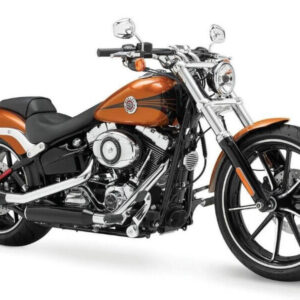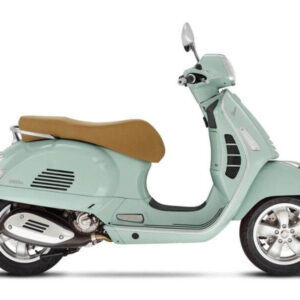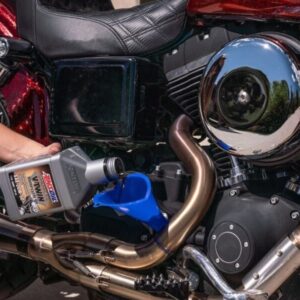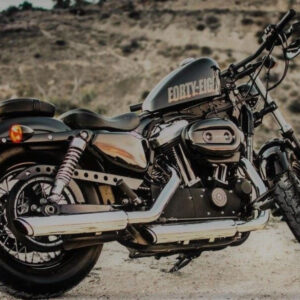What is a knucklehead? The Harley Davidson Knucklehead is a revered motorcycle engine with a rich history dating back to the mid-1930s. Named for its distinct shape characterized by bulbous rocker boxes sat on top of the cylinder head, this particular motor marked a significant milestone for the company as it surged ahead of its then-competitor, Indian.
What Is a Knucklehead?
The knucklehead is a retronym used by enthusiasts to refer to a Harley-Davidson motorcycle engine, so named because of the distinct shape of the rocker boxes.

The engine is a two-cylinder, 45 degree, pushrod actuated overhead valve V-twin engine with two valves per cylinder. It was the third basic type of V-Twin engine used by Harley-Davidson, replacing the Flathead-engined VL model in 1936 as HD’s top-of-the-line model.
The engine was manufactured until 1947 and was replaced by the Panhead engine in 1948. The Knucklehead-engined models were originally referred to as “OHVs” by enthusiasts of the time and in Harley’s official literature; the nickname arose from the California chopper culture of the late 1960s.
As the design of Harley-Davidson engines has evolved through the years, the distinctive shape of each model’s valve covers has allowed Harley enthusiasts to classify an engine simply by looking for those shapes. The contours of a knucklehead engine’s valve covers resemble knuckles on a person’s fist.
Engine and Performance
The Harley Davidson Knucklehead motor was the company’s first production overhead valve V-twin. This two-cylinder, 45-degree motor features pushrod actuated overhead valves with two valves per cylinder.
Lubrication System
The Knucklehead introduced an improved circulating oil system, which was a significant upgrade from previous models. This contributed to the engine’s ability to handle heat and led to longer life and better reliability. It also provided more efficient cooling for the motor, enhancing its overall performance.
Horsepower
While specific HP ratings for the Knucklehead can vary, the “E” motor, with its improved heat management and more direct intake and exhaust flow paths, essentially doubled the power available to the rider compared to previous models.
This increase in HP allowed for a more powerful and enjoyable riding experience, making the Knucklehead a popular choice among motorcycle enthusiasts.
Model Variations

EL Model
The EL of the Harley Davidson Knucklehead was first introduced in 1936. It featured an overhead valve, 45-degree V-twin with a displacement of 61 cubic inches (988 cc). The bore and stroke for this motor measured 3.31″ x 3.50″, and it produced 40 HP at a compression ratio of 7:1.
Equipped with a 1.25-inch Linkert carburetor, the EL utilized a duplex chain for its primary drive, and a chain for its final drive. The transmission consisted of a 4-speed, hand-shift/foot-clutch mechanism, and the bike was fitted with drum brakes on both the front and rear.
FL Model
The FL of the Knucklehead series was introduced in 1941, featuring a slightly larger 74 cubic inches displacement. This increase in size allowed for improved performance and power output, making the FL a popular choice among Harley Davidson enthusiasts.
Other improvements that had been made by this time included stiffer valve springs an totally covered motor top end.
Both EL and FL models were significant precursors to the subsequent Panhead and Shovelhead engines that Harley would later release.
Design and Features
Rocker Boxes
The Harley Knucklehead is known for its distinctive shape of the rocker boxes. These boxes feature a unique “knucklehead” design, characterized by bulging, knobby contours on top of the cylinders. This feature has made the engine a popular choice among chopper builders and motorcycle enthusiasts.
Foot Clutch
Another notable design aspect of the Knucklehead is the foot clutch. This system allows riders to shift gears using their foot, providing more control and flexibility while riding. The foot clutch is a classic feature that is still appreciated by many in the motorcycle community today.
Art Deco Styling
Harley Davidson’s Knucklehead engine also showcases Art Deco-inspired styling. This design approach, popular in the 1930s and 1940s, is marked by streamlined, symmetrical shapes and bold geometric contours. This era-defining aesthetic can be seen in various aspects of the Knucklehead, from its engine design to the overall motorcycle build.
Sidecar Options
When the Harley Davidson Knucklehead was first introduced, sidecar options were available for riders who wanted to add an extra level of functionality and style to their motorcycles.
These sidecars were designed to match the motorcycle’s overall Art Deco aesthetic and enhance the typical riding experience. While sidecar usage has decreased over time, it remains an intriguing aspect of the Knucklehead’s design history.
Knucklehead Successors

Panhead
The Panhead engine succeeded the Harley Davidson Knucklehead in 1948 and was produced until 1965. It got its name from the distinct shape of its rocker covers, resembling upside-down pans. The Panhead engine had several improvements, including aluminum cylinder heads, which reduced engine weight and improved cooling.
This new engine had hydraulic valve lifters, making it quieter and less demanding in terms of maintenance. The Panhead also saw the introduction of telescopic front forks, improving suspension and handling on Harley Davidsons at the time.
Shovelhead
The Harley Shovelhead succeeded the Panhead in 1966 and was produced until 1984. This engine inherited its name from the appearance of the rocker covers, which resembled an upside down coal shovel. The Shovelhead brought further improvements to the Harley motorbikes, such as increased capacity and more power.
Some of the Shovelhead’s key features were a larger bore size and better oil circulation, translating to better performance and reliability. The motor was initially available with either a generator- or alternator-style charging system, but eventually, the generator version was phased out.
Evolution
The Harley Evo engine was the last new motor of the 20th century for Harley and improved on the Shovelhead in several ways. It had a more efficient design with aluminum heads and cylinders which improved cooling, and it had fewer parts than the Shovelhead which made it more reliable and easier to maintain.
The Evolution also had hydraulic valve lifters which eliminated the need for regular valve adjustments, and it had a stronger bottom end which allowed it to handle more power. Overall, the Evolution was a significant improvement over the Shovelhead and it became the standard motor for Harley Davidson motorcycles from 1984 to 1999.
In summary, the Panhead, Shovelhead and Evolution models succeeded the Knucklehead, each bringing new advancements and improvements in performance, reliability, and comfort. All these successors of the previous century are still cherished and sought after by enthusiasts today for their distinct design and HD heritage.
Legacy and Significance
The Harley Knucklehead, introduced in 1936, marked a significant turning point in the history of the company. This innovative machine not only outperformed its main competitor, Indian, but also set new standards for reliability among American motorbikes.
In the world of American biker enthusiasts, the Knucklehead has become a symbol of engineering excellence and is much sought-after by collectors.
The Wheels Through Time museum, for example, houses several rare editions of the Knucklehead, including a Teak Red, 61-cubic-inch version. Bikers who have had the privilege of riding a Knucklehead often attest to its smooth ride and impressive handling.
One of the major reasons for the Knucklehead’s lasting legacy is its groundbreaking design. With overhead valve V-twin technology it achieved greater power and improved the overall performance of their machines. This advancement allowed bikers to travel faster and farther, contributing to the enduring appeal of the brand.
The Knucklehead’s reliability also played a major role in its historical significance. HD from this era were known for their durability and longevity, giving bikers confidence in the brand. This reputation for reliability continues to hold true for both vintage and contemporary HD bikes.
FAQs
What is the difference between a Panhead and a Knucklehead?
The Panhead engine succeeded the Harley Davidson Knucklehead in 1948 and was produced until 1965. It got its name from the distinct shape of its rocker covers, resembling upside-down pans. The Panhead engine had several improvements, including aluminum cylinder heads, which reduced engine weight and improved cooling.
Why was Harley engine called Knucklehead?
Prior to the “61”, a side-valve engine called a “flathead” had been powering riders through thick and thin. The “61” featured a new engine and transmission. With its overhead valves, it offered more power. It was eventually nicknamed the “Knucklehead” due to its resemblance to a clenched fist.
Are Harley knuckleheads rare?
That makes an E Knucklehead one of the rarest and most desirable models today. The war ended civilian production for a time, and the last of the Knuckles was produced in 1947, before the new bike, later referred to as the Panhead (the valve covers looked like pie pans) was introduced in 1948.
Above is information about What is a knucklehead? that we have compiled. Hopefully, through the above content, you have a more detailed understanding of What is the difference between a Panhead and a Knucklehead? Thank you for reading our post.









